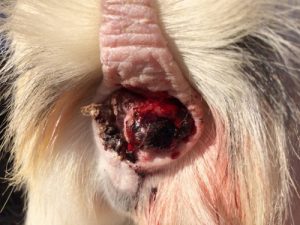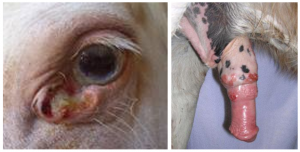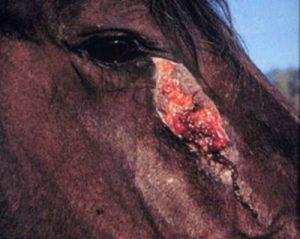Large animal cutaneous neoplasia
Squamous cell carcinoma
Presentation
As in other species, SCC affects light colored skin and external mucosa in older animals. Predilection sites in large animals include the eye (white faced cattle, Appaloosa and Paint horses), the penis (especially older geldings, potentially related to smegma buildup), the vulva and areas of trauma (eg burns or chronic wounds). Risk factors include papillomavirus infections, UV irradiation and trauma. Haflinger and Belgian horses have been shown to have genetic mutations that put them at increased risk.

In the eye, common sites are the limbus and eyelids.

SCC skin lesions are often ulcerated rather than raised. Penile lesions can be ulcerative or proliferative.

Nonhealing wounds should be biopsied to rule-out SCC. If it looks like proud flesh and is above the carpus and hock, think SCC, sarcoid or fungal infection. Horses with penile SCC are at greater risk of having ocular SCC so both areas should be checked carefully. 
Habronemiasis (below) also affects the periocular area and penis; it can look like SCC but isn’t common in Minnesota.

For differential lists between sarcoids, SCC and melanomas, if the tumor is:
- on skin and raised, think sarcoid
- on skin (or mucocutaneous junction) and ulcerated, think SCC
- on mucosa (eg penis), think SCC
- black -> melanoma (be aware that the normal skin covering eyelid sarcoids can make them look black; if a gray horse, think melanoma; if a bay horse think sarcoid)
Similar to other species, SCC’s are locally invasive and are slow to metastasize but can do so in rare cases. It is important to assess regional lymph nodes. The nodes may be enlarged due to metastases or to inflammation.
Equine glanders is not currently seen in the US but is an important differential (at least for NAVLE).
SCC is the most common tumor seen in goats; the tumor is most commonly found in the perineal area.
Treatment
Treatment generally involves resection with wide margins. This can mean enucleation, third eyelid resection and penile amputation or ablation. The wound margins are then monitored closely for recurrence and/or treated to remove any remaining tumor cells. This can mean laser ablation, radiation treatment or cryotherapy. Penile and vulvar lesions are often treated with 5-fluorouracil (5FU) cream. Periocular tumors may be treated with imiquimod, mitomycin C, specific NSAIDs and/or photodynamic therapy. While vulvar lesions are treated daily and still tend to be very aggressive, penile lesions can be treated every 2 weeks with good efficacy for smaller lesions. The sheath seems to maintain effective levels of the drug between treatments.
Key Takeaways
Squamous cell carcinoma acts similarly across species:
- Most frequent in white skin areas, near the eye and on the penis
- Associated with uv radiation and chronic trauma
- Locally invasive but rarely metastasize
- Affects older animals (chronic genetic damage)
Treat with wide margin excision, cryotherapy and/or laser debulking.
Resources
SCC in horses an update, Vet Clin Equine 40 (2024) 421–430
Cutaneous squamous cell carcinoma (SCC): “What’s the problem?”. Equine Vet Educ Vol.31(12), pp.635-646, 2019
Penile and preputial tumours in the horse: literature review and proposal of a standardised approach. Eq Vet J 42:746-757, 2010
exuberant granulation tissue
surgical removal of as much of tumor as possible

